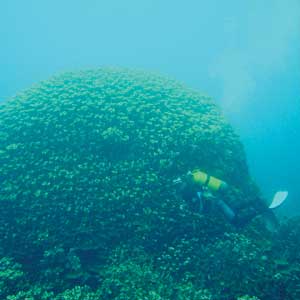|
NEWS NOTES — NEWS
Soils
Kenyan erosion portends problems
 |
| Researchers recently drilled into corals off Easter Island (pictured here) and Kenya to learn about past changes. Corals off the coast of Kenya show that soil erosion increased dramatically following colonization of the country around 1900. Photograph is courtesy of Robert Dunbar. |
You might think that any evidence of soil washed into the ocean hundreds of years ago is lost forever. But ancient coral reefs off the coast of Kenya harbor a detailed diary that tells the story of soil erosion in the country over the last 300 years, and scientists are now reading it, page by page. Their study shows that shortly after the year 1900 — approximately when British colonization of the region began — loss of fertile topsoil increased dramatically and has been on the rise ever since, painting a gloomy picture for the country’s economic and environmental future.
Soil erosion is a serious problem in Kenya, endangering the nation’s food security and threatening its terrestrial ecosystems and near-shore marine environments. But because of a lack of long, continuous records, the patterns of soil erosion are largely unknown, says Dominik Fleitmann of the University of Bern.
Fleitmann and his colleagues drilled into Porites coral at the Malindi reef, a marine park located at the Sabaki River mouth on the Kenya coast. The Sabaki drains more than 10 percent of the country’s lands, carrying with it fertile topsoil that is rich in clay minerals. These clay compounds contain barium salts that dissolve in the ocean, settle onto the reefs, and, over time, become part of the corals’ calcium carbonate skeletons.
“When you slice these coral cores and take X-ray photographs you can see their annual growth because it leaves well-defined bands, similar to the rings you find in trees,” Fleitmann says. The team, which reported the findings Feb. 22 in Geophysical Research Letters, analyzed the barium to calcium ratios by sampling the sliced cores at continuous intervals and obtained several data points for every year. The detailed record they established of the past 300 years showed a sharp rise in barium after the year 1900, reaching a five- to tenfold increase in recent decades relative to natural levels.
Establishing such records quantifies the rate at which cultivatable land is lost, which will “help environmental managers estimate how bad the problem is” and to devise plans for mitigation, says Daniel Sinclair of the Scottish Association for Marine Science.
“This is a very interesting study and it shows that Kenya needs to get a hold on their sediment and erosion problems,” adds Chuck Holmes of the U.S. Geological Survey in St. Petersburg, Fla.
Fleitmann and his colleagues attribute the dramatic changes after the turn of the last century to the start of British settlements and the subsequent change from traditional agriculture to intensive European land-use practices. Colonialism was accompanied by large-scale deforestation and the replacement of traditional crops with less-drought-resistant crops, as well as forced resettlement. “These corals tell the story of colonial folly in Africa and the long timescale of the penalty paid as the topsoils of Africa washed into the sea,” says Robert Dunbar of Stanford University, principal investigator of the study.
Without effective modern soil conservation policies, the situation will likely worsen in the future, as the increasing food demand of Kenya’s growing population will lead to still more intensive land use, Fleitmann says. “Amid all the talk about global warming, soil erosion has become a forgotten environmental problem,” he says. “The hockey stick — a graph that shows the rise in Earth’s temperatures over the past centuries — has become famous as an illustration of global warming. Our study shows that there is a hockey stick for soil erosion as well.”

 Subscribe
Subscribe


